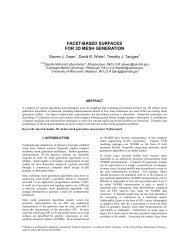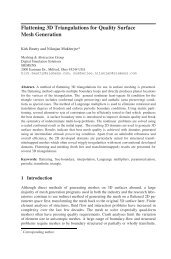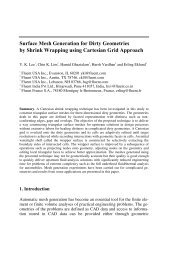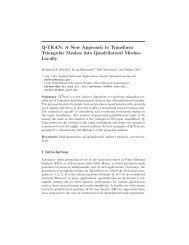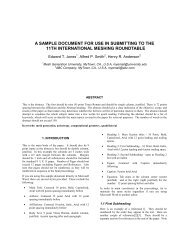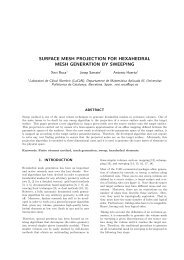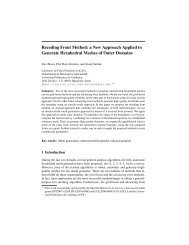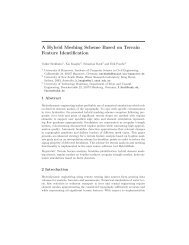Fitting Polynomial Surfaces to Triangular Meshes with Voronoi ...
Fitting Polynomial Surfaces to Triangular Meshes with Voronoi ...
Fitting Polynomial Surfaces to Triangular Meshes with Voronoi ...
Create successful ePaper yourself
Turn your PDF publications into a flip-book with our unique Google optimized e-Paper software.
8 Vincent Nivoliers, Dong-Ming Yan, and Bruno Lévy<br />
empty <strong>Voronoi</strong> cells<br />
Fig. 5: Top: the minimizer of ˜F T →S has spurious parts that cannot be eliminated<br />
since their <strong>Voronoi</strong> cells do not intersect the input mesh T . Bot<strong>to</strong>m: the symmetrized<br />
˜F = ˜F T →S + ˜F S→T detects and eliminates them.<br />
shown in Figure 5. These spurious parts correspond <strong>to</strong> the set S − Π S (T ),<br />
that does not yield any term in F T →S . In terms of the discretization ˜F S→T ,<br />
they correspond <strong>to</strong> <strong>Voronoi</strong> cells that have an empty intersection <strong>with</strong> T .<br />
3.4 Solution Mechanism<br />
To minimize the function ˜F = ˜F T →S + ˜F S→T + λR(X) in Equation 3, VSDM<br />
uses the L-BFGS algorithm [17, 13]. L-BFGS is a New<strong>to</strong>n-type algorithm, that<br />
uses successive evaluation of the function and its gradient <strong>to</strong> compute an<br />
approximation of the inverse of the Hessian. Although only the gradient is<br />
required in the computation, the objective function needs <strong>to</strong> be C 2 <strong>to</strong> ensure<br />
the proper convergence of the L-BFGS algorithms. We discuss here about the<br />
continuity of the three terms of ˜F :<br />
• The term R(X) is a quadratic form (C ∞ ) ;<br />
• the term ˜F T →S corresponds <strong>to</strong> the quantization noise power, which is the<br />
objective function minimized by a centroidal <strong>Voronoi</strong> tesselation. It is of<br />
class C 2 , except in some rarely encountered degenerate configurations<br />
(see [14] for a proof) ;<br />
• the term ˜F S→T is obtained by permuting the roles of the constant and<br />
variables in ˜F T →S . We will study its continuity in future work. Experimentally,<br />
it is regular enough for obtaining a stable behavior of L-BFGS.




